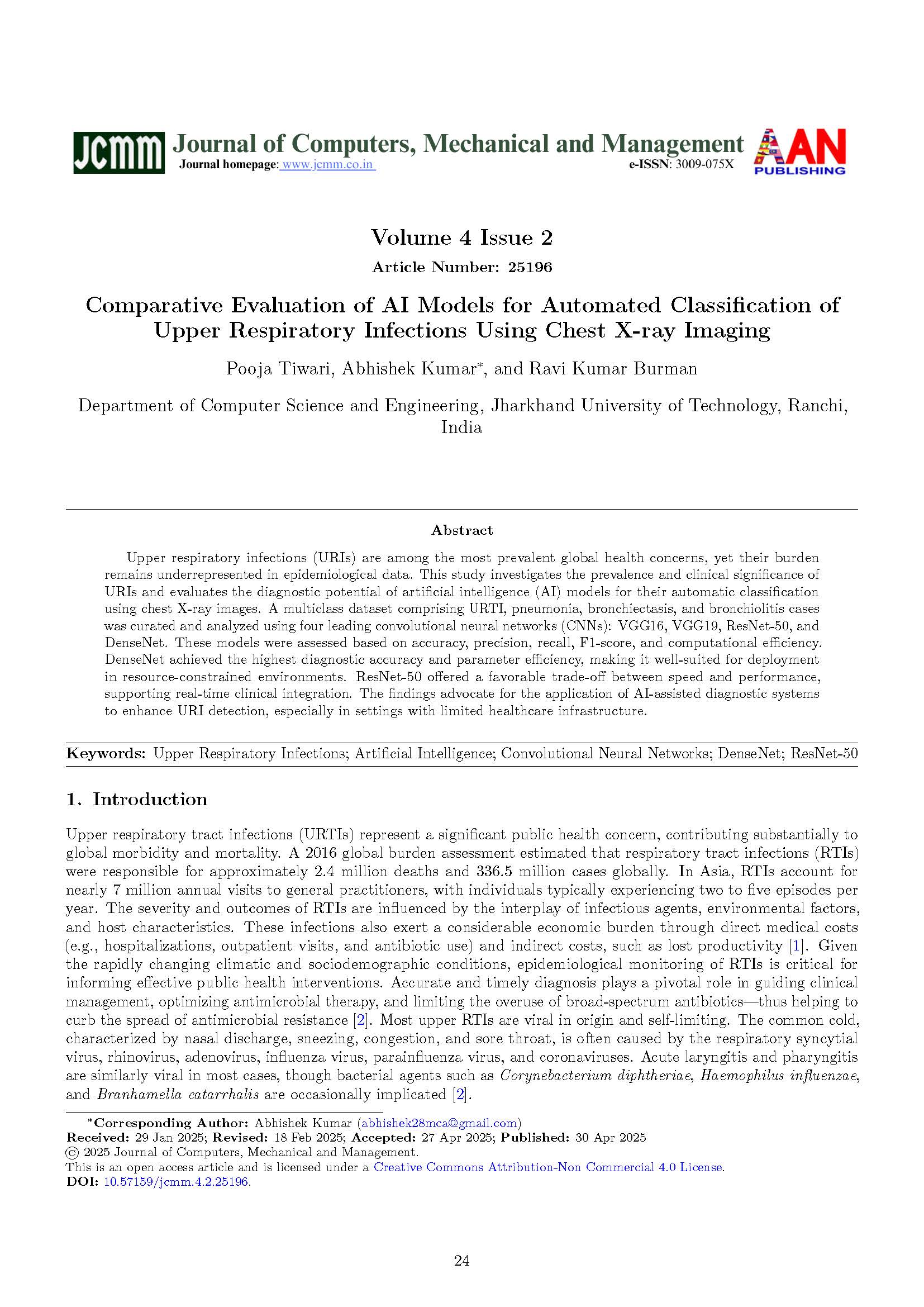Compare and evaluate AI models for automatically classifying and categorizing URIs
DOI:
https://doi.org/10.57159/jcmm.4.2.25196Keywords:
Upper Respiratory Infections, Artificial Intelligence, Convolutional Neural Networks, DenseNet, ResNet-50Abstract
URIs, or upper respiratory infections, are among the most prevalent illnesses. Nevertheless, a thorough assessment of the associated burden has not been conducted.Thus, this study's goal is to outline the global and regional burden of URIs. In environments with limited resources, artificial intelligence (AI) systems that use symptoms and signals to identify URTI (upper respiratory tract infection), Pneumonia Bronchiectasis, Bronchiolitis with the help of Such AI systems heterogeneity makes performance analysis necessary to guide future research. Strong evidence exists to encourage more research into machine learning's ability to automatically identify pneumonia based on symptoms and indicators that are easily recognized. Based on the results of this study, suggestions are given for developing and utilizing AI tools, which should enhance the effectiveness of subsequent research.
References
A. K. Grech, C. T. Foo, E. Paul, A. K. Aung, and C. Yu, “Epidemiological trends of respiratory tract pathogens detected via mPCR in Australian adult patients before COVID-19,” BMC Infectious Diseases, vol. 24, no. 1, p. 38, 2024.
A. Calderaro, M. Buttrini, B. Farina, S. Montecchini, F. De Conto, and C. Chezzi, “Respiratory tract infections and laboratory diagnostic methods: A review with a focus on syndromic panel-based assays,” Microorganisms, vol. 10, no. 9, p. 1856, 2022.
J. Becker et al., “Artificial intelligence-based detection of pneumonia in chest radiographs,” Diagnostics, vol. 12, no. 6, p. 1465, 2022.
A. B. Godbin and S. G. Jasmine, “Analysis of pneumonia detection systems using deep learning-based approach,” in Proceedings of the 2022 International Conference on Innovative Computing, Intelligent Communication and Smart Electrical Systems (ICSES), pp. 1–6, 2022.
G. M. M. Alshmrani, Q. Ni, R. Jiang, H. Pervaiz, and N. M. Elshennawy, “A deep learning architecture for multi-class lung diseases classification using chest x-ray (CXR) images,” Alexandria Engineering Journal, vol. 64, pp. 923–935, 2023.
A. M. Alqudah, S. Qazan, and Y. M. Obeidat, “Deep learning models for detecting respiratory pathologies from raw lung auscultation sounds,” Soft Computing, vol. 26, no. 24, pp. 13405–13429, 2022.
S. Panigrahi, B. S. Nanda, R. Bhuyan, K. Kumar, S. Ghosh, and T. Swarnkar, “Classifying histopathological images of oral squamous cell carcinoma using deep transfer learning,” Heliyon, vol. 9, no. 3, p. e13444, 2023.
S. G. Gundabatini, M. R. N. D. LakshmiRoshini, M. N. Sri, P. Deepthi, and P. S. Teja, “Pneumonia detection using CNN, ResNet, and DenseNet,” International Journal for Research in Applied Science and Engineering Technology (IJRASET), vol. 9, no. 6, pp. 2321–9653, 2021.
B. Ilhan, K. Lin, P. Guneri, and P. Wilder-Smith, “Improving oral cancer outcomes with imaging and artificial intelligence,” Journal of Dental Research, vol. 99, no. 3, pp. 241–248, 2020.
M. Bansal, M. Kumar, M. Sachdeva, and A. Mittal, “Transfer learning for image classification using VGG19: Caltech-101 image data set,” Journal of Ambient Intelligence and Humanized Computing, vol. 14, no. 4, pp. 3609–3620, 2023.
I. Amin, H. Zamir, and F. F. Khan, “Histopathological image analysis for oral squamous cell carcinoma classification using concatenated deep learning models,” medRxiv, 2021.
A. A. Akl, K. M. Hosny, M. M. Fouda, and A. Salah, “A hybrid CNN and ensemble model for COVID-19 lung infection detection on chest CT scans,” PLOS ONE, vol. 18, no. 3, p. e0282608, 2023.
T. T. Ifty, S. A. Shafin, S. M. Shahriar, and T. Towhid, “Explainable lung disease classification from chest x-ray images utilizing deep learning and XAI,” in Proceedings of the 2024 International Conference on Multimedia Interaction (ICMI), pp. 1–5, 2024.
K. Subramaniam et al., “A comprehensive review of analyzing the chest x-ray images to detect COVID-19 infections using deep learning techniques,” Soft Computing, vol. 27, no. 19, pp. 1–15, 2023.
S. Singh, M. Kumar, A. Kumar, B. K. Verma, K. Abhishek, and S. Selvarajan, “Efficient pneumonia detection using vision transformers on chest x-rays,” Scientific Reports, vol. 14, no. 1, p. 2487, 2024.

Downloads
Published
How to Cite
Issue
Section
Categories
License
Copyright (c) 2025 Journal of Computers, Mechanical and Management

This work is licensed under a Creative Commons Attribution-NonCommercial 4.0 International License.
The Journal of Computers, Mechanical and Management applies the CC Attribution- Non-Commercial 4.0 International License to its published articles. While retaining copyright ownership of the content, the journal permits activities such as downloading, reusing, reprinting, modifying, distributing, and copying of the articles, as long as the original authors and source are appropriately cited. Proper attribution is ensured by citing the original publication.





